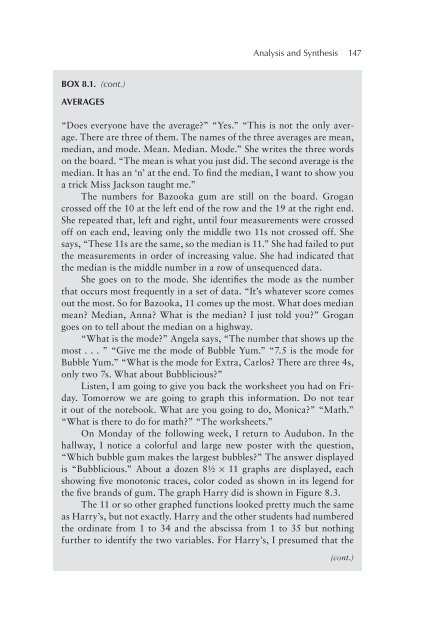How Things Work - Doha Academy of Tertiary Studies
How Things Work - Doha Academy of Tertiary Studies
How Things Work - Doha Academy of Tertiary Studies
Create successful ePaper yourself
Turn your PDF publications into a flip-book with our unique Google optimized e-Paper software.
BOX 8.1. (cont.)<br />
aveRaGes<br />
analysis and Synthesis 147<br />
“Does everyone have the average?” “Yes.” “This is not the only average.<br />
There are three <strong>of</strong> them. The names <strong>of</strong> the three averages are mean,<br />
median, and mode. Mean. Median. Mode.” She writes the three words<br />
on the board. “The mean is what you just did. The second average is the<br />
median. It has an ‘n’ at the end. To find the median, I want to show you<br />
a trick Miss Jackson taught me.”<br />
The numbers for Bazooka gum are still on the board. Grogan<br />
crossed <strong>of</strong>f the 10 at the left end <strong>of</strong> the row and the 19 at the right end.<br />
She repeated that, left and right, until four measurements were crossed<br />
<strong>of</strong>f on each end, leaving only the middle two 11s not crossed <strong>of</strong>f. She<br />
says, “These 11s are the same, so the median is 11.” She had failed to put<br />
the measurements in order <strong>of</strong> increasing value. She had indicated that<br />
the median is the middle number in a row <strong>of</strong> unsequenced data.<br />
She goes on to the mode. She identifies the mode as the number<br />
that occurs most frequently in a set <strong>of</strong> data. “It’s whatever score comes<br />
out the most. So for Bazooka, 11 comes up the most. What does median<br />
mean? Median, Anna? What is the median? I just told you?” Grogan<br />
goes on to tell about the median on a highway.<br />
“What is the mode?” Angela says, “The number that shows up the<br />
most . . . ” “Give me the mode <strong>of</strong> Bubble Yum.” “7.5 is the mode for<br />
Bubble Yum.” “What is the mode for Extra, Carlos? There are three 4s,<br />
only two 7s. What about Bubblicious?”<br />
Listen, I am going to give you back the worksheet you had on Friday.<br />
Tomorrow we are going to graph this information. Do not tear<br />
it out <strong>of</strong> the notebook. What are you going to do, Monica?” “Math.”<br />
“What is there to do for math?” “The worksheets.”<br />
On Monday <strong>of</strong> the following week, I return to Audubon. In the<br />
hallway, I notice a colorful and large new poster with the question,<br />
“Which bubble gum makes the largest bubbles?” The answer displayed<br />
is “Bubblicious.” About a dozen 8½ × 11 graphs are displayed, each<br />
showing five monotonic traces, color coded as shown in its legend for<br />
the five brands <strong>of</strong> gum. The graph Harry did is shown in Figure 8.3.<br />
The 11 or so other graphed functions looked pretty much the same<br />
as Harry’s, but not exactly. Harry and the other students had numbered<br />
the ordinate from 1 to 34 and the abscissa from 1 to 35 but nothing<br />
further to identify the two variables. For Harry’s, I presumed that the<br />
(cont.)

















